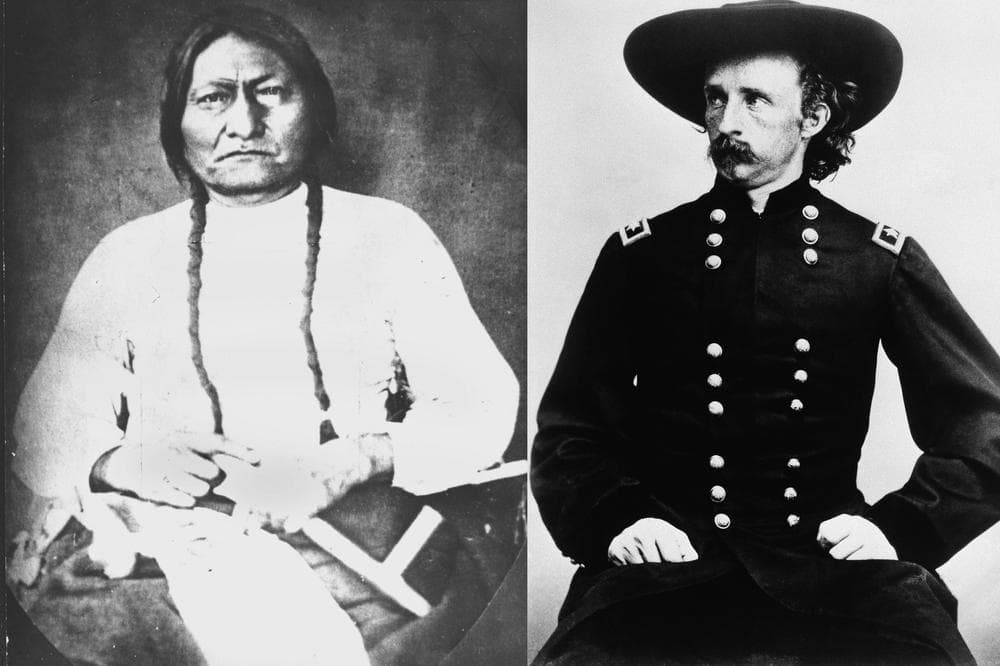Advertisement
The Battle Of Little Big Puck: Hockey Meets History
Resume
By Amy Jo Ehman
More than 130 years ago, Sitting Bull arrived in Canada on the run after defeating Colonel Custer at the Battle of the Little Big Horn. He stayed just four years, but his presence had a lasting impact on the people who live north of the border – both the ranchers and the Cree. A tribute to that colorful history plays out, once a year, at the hockey rink in Maple Creek, Saskatchewan, in a charity game known locally as the Battle of the Little Big Puck.
The cowboys and the Cree faced off at center ice on February 25. Between them, as referee, was the local Mountie. The town folk of Maple Creek, population 2200, came out to watch.
The cowboys are all local ranchers who are, or have been, members of a rodeo association. The Cree are all members of the Nekaneet First Nation, a reserve just south of town in the Cypress Hills.
The cowboys got off to a rough start. At the end of the second period, the score was 9-6 for the Cree.
Joe Braniff has played for the cowboys for 25 years. He recalls how this game of Cowboys versus Indians got its start.
[sidebar title="Native American Images In Sports" width="300" align="right"] While the Native Americans who play in the Battle of Little Big Puck are comfortable with the game's "Cowboys & Indians" motif, the use of tribal imagery in sports can be controversial. In February, Only A Game examined the legal battles over the University of North Dakota's "Fighting Sioux" nickname. [/sidebar]"The roots go back to a hot summer day in July where a couple of cowboys and a couple of members of the Nekaneet band met in the old Commercial Hotel over a cold beer," he said. "And as good friends do, they got to bickering good naturedly as to who could ride the rankest horses, and rope the quickest, and pretty soon it came down to, 'We can darn sure beat you guys at hockey.'"
That friendly challenge has stayed friendly, despite the potential pitfalls. Braniff said in 30 years, there’s never been a fight.
"You might be hard pressed to find a community anywhere in Canada where you could call it a Cowboy-Indian game and not offend anybody, where you could put two cultures against each other in a hockey game with bragging rights and everything else at stake and not turn it into a war. Both sides are very proud of that."
Dale Mosquito plays for the Cree. He said this hockey game is a point of pride for the people of Nekaneet, whose ancestors lived here long before the cowboys arrived.
"You know, we’re proud of our heritage," he said." "We’ve always coexisted with the town of Maple Creek, and for us, that’s tradition, and the Battle of the Little Big Puck helps us celebrate that fact."
That relationship between Cree and cowboy was shaped, in no small part, by another battle: The Battle of the Little Big Horn.
After Col. Custer’s defeat in 1876, 5000 Lakota and their leader, Sitting Bull, crossed the border into Canada and sought refuge southeast of present day Maple Creek. Their arrival was peaceful, according to local historian Royce Pettyjohn, but strained relations between the two countries.
"Essentially you’ve got, from the American perspective, an undefeated hostile force on their northern border and they were concerned with what today would be termed homeland security," Pettyjohn said. "They were concerned about the Lakota raiding down into the United States and then coming back into the safety of Canada."
And for Canada, the presence of Sitting Bull and these refugees of war from the United States represented a potential wrench to be thrown into that nice peaceful orderly process of westward expansion.
Four years later, Sitting Bull returned to the U.S., but Canadian authorities were taking no chances. They decided to move all the Cree away from the border, to designated reserves far to the north.
But one chief, Chief Nekaneet, and his people, refused to go. They lived freely, made friends with the settlers, worked on their farms and learned to rodeo. Eventually, with the help of sympathetic ranchers, Nekaneet’s descendants were granted their reserve in the Cypress Hills.
"I think that’s part of the reason why today you can have an event like the Battle of the Little Big Puck," said Pettyjohn. "You have for the benefit of charity, a game that pays tribute to that integrated past of essentially cowboys and Indians."
Back at the hockey rink, it’s the third period and both teams have switched from their hockey gear to more traditional outfits – they’re dressed as cowboys and Indians. It’s a colorful mix of chaps and cowboy hats – feathers, face paint and beads. The Mountie has changed from the black and white referee jersey to his bright red coat and stetson. Dale Mosquito, now dressed in moose hide, said he’s proud to be a role model for a younger generation, including his own son.
"I don’t know how much longer I’ll be able to lace up the skates," Mosquito said. "I’m really excited that they’re deciding and pursing this opportunity because I think they’ll carry it long into the future."
This segment aired on March 10, 2012.